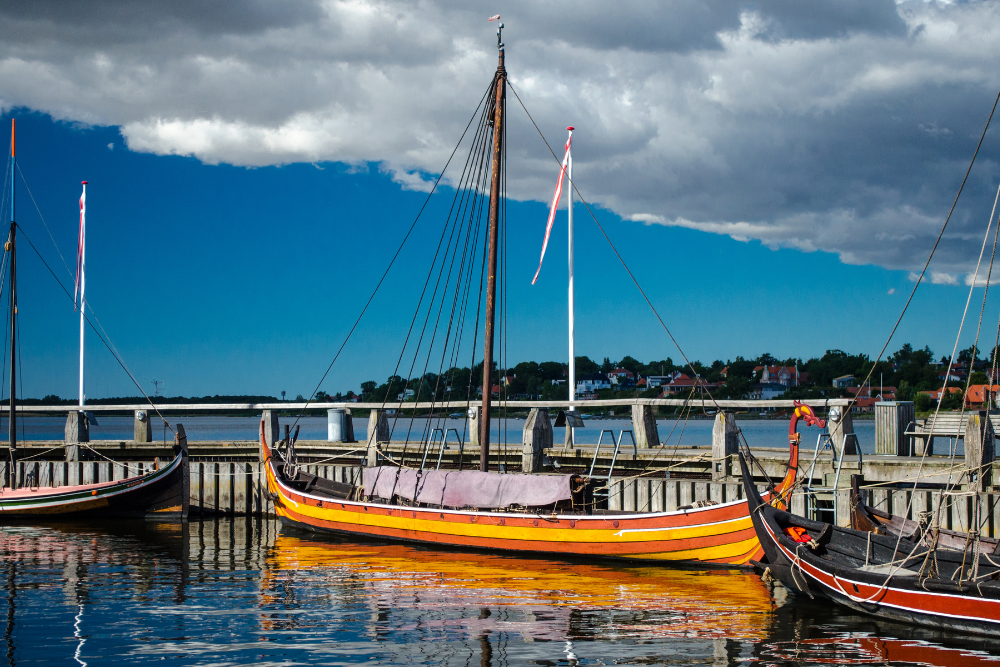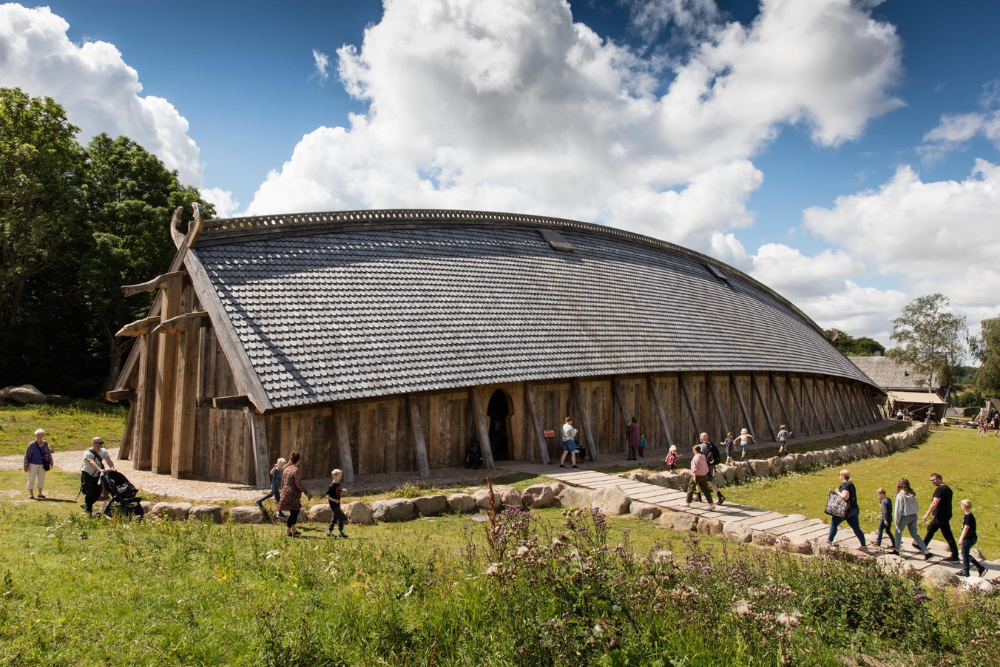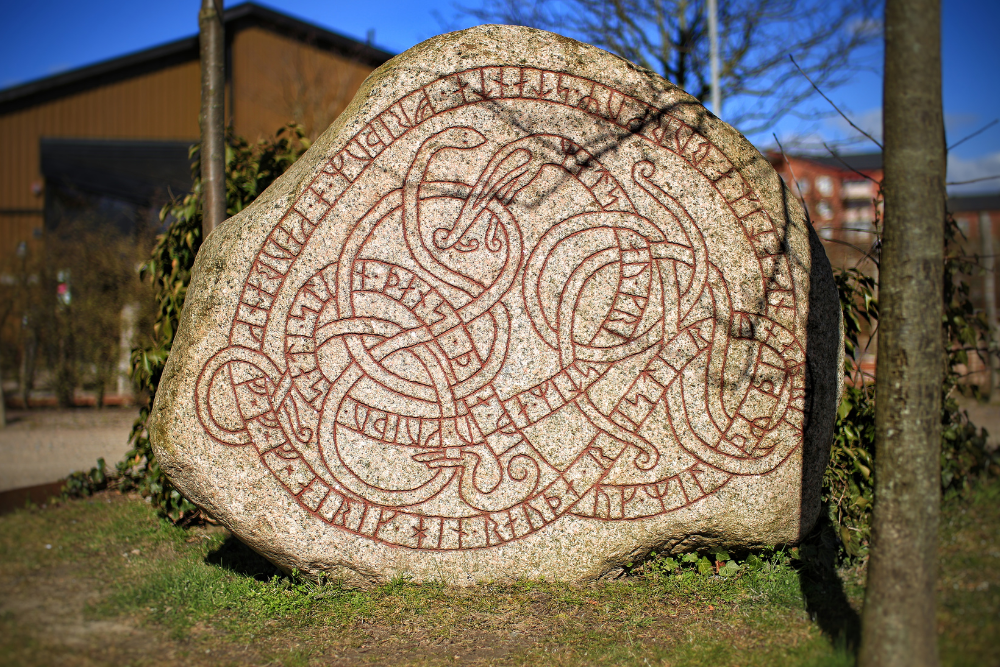Denmark is often considered the heart of the Viking world, as it was home to some of the most famous Viking rulers, warriors, and settlements. From ancient burial mounds to reconstructed Viking villages, Denmark offers a wealth of Viking heritage to explore. Whether you’re a history enthusiast or simply curious about Viking culture, visiting these sites will give you an unforgettable glimpse into the world of the Norsemen. Here’s a guide to some of Denmark’s most famous Viking sites.
1. Jelling: The Viking Heart of Denmark

Often regarded as the cradle of Danish history, Jelling is home to two massive burial mounds, a rune stone, and the ruins of a Viking church. Located in the heart of Jutland, Jelling is where Denmark’s first Christian king, King Gorm the Old, and his son, King Harald Bluetooth, are buried.
- What to see:
- The Jelling Rune Stones, erected by Harald Bluetooth in the 10th century, are UNESCO World Heritage sites. They commemorate the conversion of Denmark to Christianity and the unification of Denmark and Norway.
- The Jelling Mounds are burial sites for Gorm the Old and his son Harald, and the largest mound is thought to be the burial site of Gorm’s wife, Thyra.
- The Jelling Church was originally built by Harald Bluetooth and stands as a testament to the early Christian influence in Denmark.
- Best time to visit: Spring and summer when the site is fully accessible, and the surrounding countryside is beautiful for walking.
2. The Viking Ship Museum in Roskilde

Located just outside Copenhagen in the historic city of Roskilde, the Viking Ship Museum is one of Denmark’s premier Viking attractions. The museum is dedicated to preserving and showcasing Viking ships, many of which were recovered from the Roskilde Fjord in the 1960s. The site also includes a reconstructed Viking shipyard where visitors can watch Viking shipbuilding in action.
- What to see:
- The museum houses five original Viking ships dating from the 11th century, which were intentionally sunk in the fjord to block enemy ships.
- Interactive exhibits allow you to learn about the Viking Age, from their seafaring skills to their trade and warfare tactics.
- You can even board a reconstructed Viking ship and experience what it would have been like to sail the open seas in the same manner as the Vikings.
- Best time to visit: Year-round, though the summer months are particularly lively with boat tours and Viking reenactments.
3. Lejre: The Viking’s Old Capital

Once the capital of the Viking kingdom, Lejre is located about 35 kilometers west of Copenhagen and is an important archaeological site that gives a glimpse into the Viking and early medieval period. The Lejre Viking Site includes reconstructed Viking homes and an open-air museum where visitors can experience life as it would have been in the 6th and 7th centuries.
- What to see:
- The Viking Age Village at Lejre features Viking-style houses made from natural materials such as wood, thatch, and clay, where visitors can experience how the Vikings lived, worked, and traded.
- The Lejre Archaeological Museum houses numerous Viking artifacts, including tools, weapons, and pottery.
- During the summer months, you can take part in various Viking-themed activities, such as archery, sword fighting, and traditional crafts.
- Best time to visit: Summer months when the Viking reenactments and living history activities are in full swing.
4. Trelleborg: The Viking Fortress

Located near the town of Slagelse on the island of Zealand, Trelleborg is one of Denmark’s best-preserved Viking ring fortresses. Built around 980 AD by King Harald Bluetooth, this fortress is a prime example of Viking military architecture and is part of a group of similar fortresses spread across Scandinavia.
- What to see:
- The Trelleborg Viking Ring Fortress consists of circular earthworks, including a trench and a rampart, which would have been used as a military encampment. The fortress’s design is believed to have been inspired by the Romans.
- The site includes a museum that showcases the discovery of Viking artifacts, including weapons, coins, and everyday objects.
- The reconstructed Viking village on the site offers insights into Viking domestic life and the fortress’s strategic significance.
- Best time to visit: Summer for reenactments and outdoor activities like archery, but the site is open year-round.
5. Viking Burial Mounds at Hiddensee Island

Though Hiddensee Island is technically part of Germany, it lies just across the Baltic Sea from Denmark and was once an important Viking settlement. The Viking Burial Mounds on the island are one of the most significant Viking archaeological sites in northern Europe.
- What to see:
- The Viking burial mounds on Hiddensee Island are burial sites for Viking chieftains and warriors, and many artifacts have been unearthed, such as weapons, jewelry, and tools.
- The island also has several reconstructed Viking houses where visitors can learn about Viking culture and lifestyle.
- Best time to visit: Summer months are ideal for enjoying the island’s scenic beauty and exploring its historical sites.
Conclusion
Denmark is a country steeped in Viking history, and its rich heritage is preserved in the many archaeological sites, museums, and ruins scattered throughout the nation. From the mighty fortresses at Trelleborg to the sacred burial grounds of Jelling, Denmark offers a treasure trove of Viking experiences. Whether you’re interested in Viking warfare, art, or daily life, these sites provide the perfect opportunities to immerse yourself in the world of the Norsemen.












